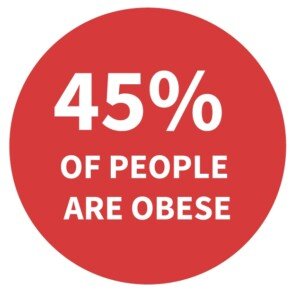It’s time to stop blaming an epidemic of morbid obesity on a tiny gland in the neck.
Americans had a thyroid 100 years ago just the same, during a time when obesity was so rare that there was a such thing as the “fat lady at the circus.”
But nowadays, obesity is so common that it’s become practically normalized. What this means is that it’s so common, that a woman who’s 130 pounds at average height is often considered thin or skinny.
When I was a personal trainer I had a 5’7 client who weighed 105 pounds and wanted to gain weight. SHE was skinny.
Yet if she were 130 pounds today, she would’ve been regarded as skinny still, because obesity is becoming increasingly common in the general population, plus celebrated on social media.
Obesity is also rampant in the United Kingdom, and has been on the rise for decades in other industrialized nations.
Overstuffing oneself with food is part of the problem. The other part is underactivity.
A sedentary lifestyle contributes to obesity. But if someone weighs 260 pounds on a 5’4 frame, increasing physical activity without cutting back on junk food isn’t going to shear off a hundred pounds.
Low Thyroid vs. Overeating in Obesity
Many laypeople believe that the average case of obesity is caused by a low thyroid. But keep in mind that obesity is very prevalent.

“Hypothyroidism — when the thyroid gland is underactive and not making enough thyroid hormone — is a relatively common problem,” says Dr. David Beatty, MD, a retired general practitioner with 30+ years of experience and an instructor of general medicine for 20 years.
“About five percent of the U.S. population over the age of 12 years is affected.
“The lifetime risk of having it is about 12 percent. Lots of people have the problem but haven’t been diagnosed.
“It’s important to make the diagnosis because many of its symptoms impair the quality of life.”
Many problems can arise from an underactive thyroid, including constipation, hair loss, lethargy, slow thinking and of course, gain of excess fat. But hypothyroidism doesn’t make a woman of average height 300 pounds, or a man of average height 400 pounds.
“General practitioners see lots of people who are overweight and who are looking for a medical cause for this,” continues Dr. Beatty.
“In the vast majority the cause is a combination of overeating and a sedentary lifestyle.
“A blood test for hypothyroidism should, of course, be done. I would estimate that out of every hundred blood tests I’ve ordered for hypothyroidism, only a couple are abnormal.
“So the other 98 can’t blame their thyroid for being overweight.
“The severity of the symptoms is usually in proportion to the severity of the deficiency. Many people with borderline low thyroid function may not have any symptoms.”
When you see a morbidly obese person walking down the street, it would not be logical to conclude, “She must have low thyroid disease.”
The more logical assumption would be, “Too much food, not enough structured exercise.”
We live in a world where it’s incredibly easy to consume too much food and not get sufficient exercise. It should be very easy to believe that these two factors in combination are the leading cause of obesity.
Though hypothyroidism does, in some instances, cause fat gain, this would mean that the individual needs to put more effort into a sustainable weight loss plan. More effort shouldn’t equate to giving up.
At the same time, a dietary approach to combating obesity should be sustainable rather than some gimmicky regimen.
A very sustainable approach to permanent, safe weight loss is that of simply cutting back on junk food.
- Replace soda with water.
- Replace juice with whole fruit.
- Restrict fast food.
- Ask yourself if you really need the butter and gravy on your foods.
- Make an effort to avoid foods that weren’t around 50,000 years ago.
- Control your portions.
- Never eat for emotional reasons such as boredom or anxiety.
- Don’t eat because other people in a social environment are eating.
“Those with an underactive thyroid need replacement treatment with thyroxine — almost always for life,” says Dr. Beatty.
“If someone is overweight because of hypothyroidism they usually gradually lose weight over many months until they plateau and reach their par weight.
“Depending on what they eat and the exercise they do, they may not reach their ideal weight.” But this doesn’t mean they should settle for morbid obesity, either.
Morbid obesity is when one is at least a hundred pounds over their ideal weight range.
“The thyroxine treatment will only shed the weight gain caused by hypothyroidism.
“Once a person has been established on the right treatment for several months — maybe a year tops — their obesity can’t be attributed to their thyroid problem.”
 Dr. Beatty has worked in primary medicine, surgery, accident and emergency, OBGYN, pediatrics and chronic disease management. He is the Doctor of Medicine for Strong Home Gym.
Dr. Beatty has worked in primary medicine, surgery, accident and emergency, OBGYN, pediatrics and chronic disease management. He is the Doctor of Medicine for Strong Home Gym.
 Lorra Garrick has been covering medical, fitness and cybersecurity topics for many years, having written thousands of articles for print magazines and websites, including as a ghostwriter. She’s also a former ACE-certified personal trainer.
Lorra Garrick has been covering medical, fitness and cybersecurity topics for many years, having written thousands of articles for print magazines and websites, including as a ghostwriter. She’s also a former ACE-certified personal trainer.
.
10 Things Obese People Blame Their Pain on Other than Weight



























